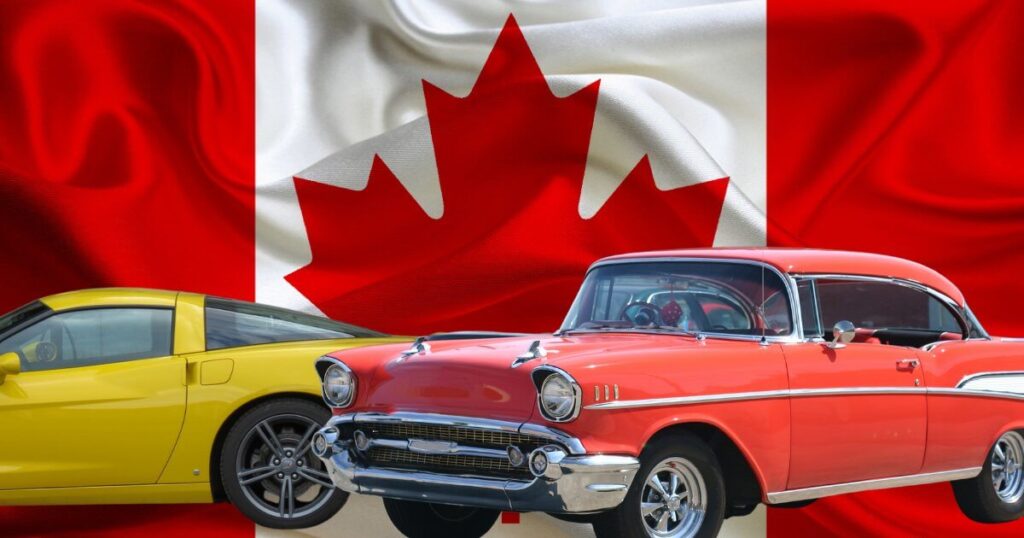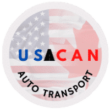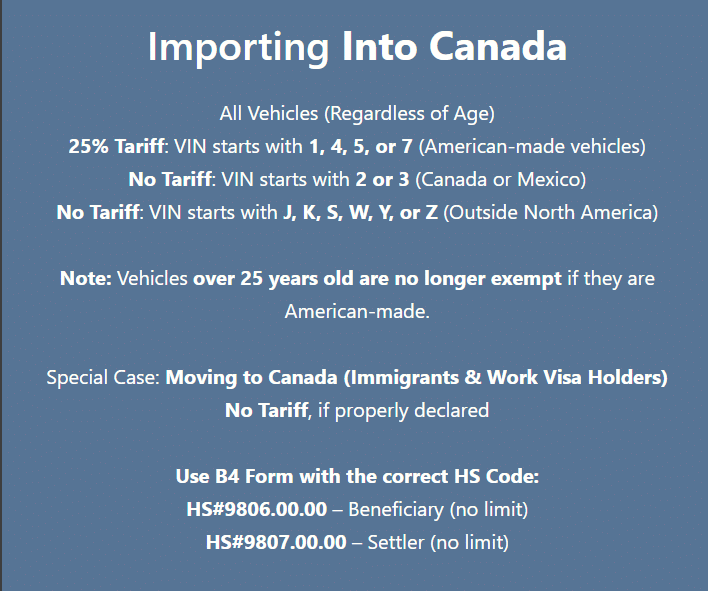Bringing a vehicle into Canada involves more than just driving across the border or arranging a shipment. While it might appear simple on the surface, the reality is that importing a car, truck, or SUV into the country is tightly governed by a set of evolving tariff rules—rules that could cost you thousands if misunderstood or overlooked.
This guide breaks down everything you need to know about vehicle import tariffs into Canada, from decoding your VIN to claiming exemptions under the right conditions. It’s the ultimate resource to help you plan smarter and avoid unexpected costs when importing a vehicle into the Canadian market.
Key Factors on Canada’s Vehicle Import Tariffs

Import duties aren’t applied uniformly. The total amount you’ll pay depends on a variety of factors, including where the vehicle was manufactured, what the VIN reveals about its origin, and your reason for bringing it into Canada. Some vehicles sail through without added charges, while others are slapped with a 25% tariff at the border. And now, even vehicles over 25 years old—once believed to be exempt—can be subject to that same hefty duty if they were made in the United States.
Immigrants, returning residents, and temporary workers also face a unique set of requirements. The good news? If you fall into one of these categories and use the correct customs forms and HS codes, you can legally avoid tariffs altogether. But skip a step, and the financial consequences could be steep.
Tariff Rates Based on VIN Number and Vehicle Origin
Did you know your vehicle’s VIN (Vehicle Identification Number) determines whether you’ll have to pay a hefty 25% import tariff?
VIN Breakdown and Country of Origin
Your vehicle’s VIN gives insight into where it was manufactured. The first digit of the VIN indicates the country of origin. Here’s why this matters:
| VIN Starts With | Country of Manufacture | Import Tariff |
| 1, 4, 5, 7 | United States | 25% |
| 2, 3 | Canada or Mexico | No Tariff |
| J, K, S, W, Y, Z | Outside North America | No Tariff |
Important Note for American-Made Vehicles
Even if your vehicle is over 25 years old, it is no longer exempt from import tariffs if it was made in the U.S. and falls under the NAFTA/USMCA manufacturing codes (1, 4, 5, 7). This change has surprised many classic car enthusiasts who previously believed they could import a 1990s American car duty-free. Not anymore.
Pro Tip:
Before making any vehicle purchase in the U.S. with the intent to import, check the VIN. If the first digit is not 2, 3, or a letter (J-Z), you may be looking at a 25% tariff. That’s a big chunk of your budget.
All Vehicles Now Subject to Tariffs — Regardless of Age

The 25% tariff on certain vehicle imports isn’t arbitrary. It’s part of Canada’s tariff regulations intended to protect domestic auto manufacturing and balance trade between countries. Vehicles built outside of Canada or Mexico, but still within North America (i.e., the United States), are unfortunately caught in this net.
This rule especially impacts used car buyers and dealers who shop for good-condition American vehicles to bring into Canada. The 25% duty, calculated on the vehicle’s value, can turn a great deal into an expensive lesson.
Special Case: Moving to Canada as an Immigrant or Temporary Worker
If you’re moving to Canada, either as a permanent resident (immigrant) or on a work visa, you may qualify for tariff exemptions—but only if you follow the right procedures.
Exemption Rules for Personal Vehicles
If you’re relocating and bringing your vehicle as part of your household goods, Canada allows a tariff exemption as long as:
- The vehicle is declared at the time of your move.
- The correct forms and Harmonized System (HS) codes are used.
This applies to:
- New immigrants
- Returning Canadians
- Temporary residents (like work visa holders)
- Foreign workers entering on assignment
The Importance of the B4 Form and HS Codes
To enjoy tariff exemptions, immigrants and temporary residents must use the Canada Border Services Agency (CBSA) form B4 (also known as the Personal Effects Accounting Document) when declaring their imported vehicle.
Which HS Code Should You Use?
| HS Code | Description | Who Should Use It | Tariff Status |
| HS#9806.00.00 | Beneficiary of exemptions, temporary residents, etc. | Work visa holders, students | No Tariff |
| HS#9807.00.00 | Settlers moving permanently to Canada | Immigrants and returning Canadians | No Tariff |
Real-Life Scenario:
John, a software engineer from California, moved to Toronto on a two-year work visa. He brought his Honda CR-V (VIN starts with 1) with him. Normally, this would face a 25% tariff. But by using B4 form and HS#9806.00.00, he successfully imported the vehicle duty-free, saving thousands.
Importing Older Vehicles Into Canada
There’s a common belief that vehicles over 25 years old can be imported without much hassle. While this is partly true for regulatory requirements, it no longer applies for tariff exemptions — especially for American-made cars.
Updated Rule:
As of the latest guidance, age is no longer a factor for tariff exemption if the vehicle is American-made (VIN starting with 1, 4, 5, or 7). This means even your 1997 Ford Mustang may incur a 25% duty upon crossing the border.
Best Practice:
Check both the age of the vehicle and the VIN origin. If you’re importing a collector’s car, and it’s not American-made, you’re more likely to avoid the tariff. If it is American-made, prepare to budget for the 25%.
Vehicles Manufactured in Canada or Mexico: Your Golden Ticket
Vehicles made in Canada (VIN starts with 2) or Mexico (VIN starts with 3) enjoy zero import duty thanks to agreements like NAFTA and its successor, USMCA. These vehicles are viewed as domestic from a trade perspective.
Example:
A Chevrolet Equinox built in Ontario (VIN starts with 2) can be brought into Canada with no tariff at all, making it a cost-effective choice for those sourcing vehicles from the U.S. market.
What About Japanese, German, or Other Non-North American Cars?
Good news here — vehicles with VINs starting with J (Japan), K (Korea), S (UK), W (Germany), Y (Sweden), or Z (Italy) typically do not incur a 25% tariff when imported into Canada.
These vehicles may still be subject to GST/HST and Registrar of Imported Vehicles (RIV) fees, but they are not subject to the additional tariff unless otherwise restricted.
Pro Tip:
When sourcing luxury or specialty vehicles, consider models made in Europe or Asia. Not only do they avoid the North American tariff pitfall, but many models also retain higher resale value in Canada.
Summary Table: Canadian Vehicle Import Tariffs
| Category | Tariff Status | Notes |
| American-made Vehicles (VIN 1, 4, 5, 7) | 25% | Applies regardless of age |
| Canadian or Mexican Vehicles (VIN 2 or 3) | No Tariff | Covered under trade agreements |
| Non-North American Vehicles (VIN J, K, etc.) | No Tariff | May be subject to RIV/GST but no additional tariff |
| Vehicles Imported as Part of a Move (HS 9806/9807) | No Tariff | Must use B4 form and correct HS Code |
| Classic Cars (Over 25 years, VIN 1,4,5,7) | 25% | No longer exempt |
Quick Checklist Before Importing a Vehicle Into Canada:
- Check the first digit of the VIN
- Know the vehicle’s country of manufacture
- Determine if you’re eligible for B4 and HS code exemptions
- Calculate total cost including potential 25% duty
- Keep all documentation at hand when crossing the border
Avoiding Costly Surprises
Vehicle import tariffs can catch you off guard, especially if you’re relying on outdated assumptions. Many importers assume vehicles over 25 years are automatically tariff-free — that’s no longer the case for American-made cars. Others think simply driving the vehicle across the border for personal use avoids taxes — not true.
Understanding the VIN code, the HS classification, and whether you qualify for special exemptions can mean the difference between a smooth import process and a budget-blowing bill.


